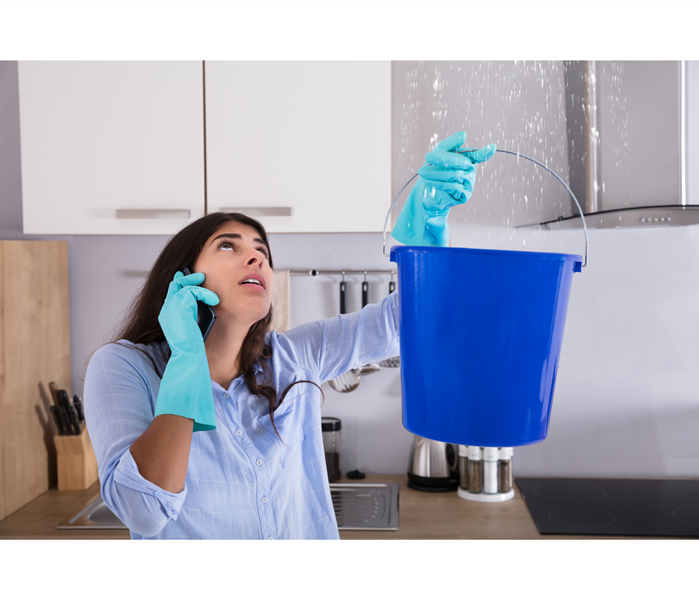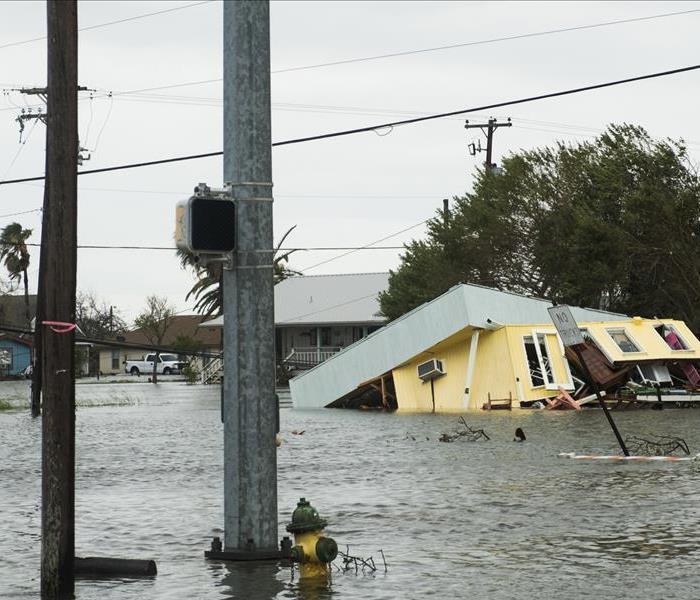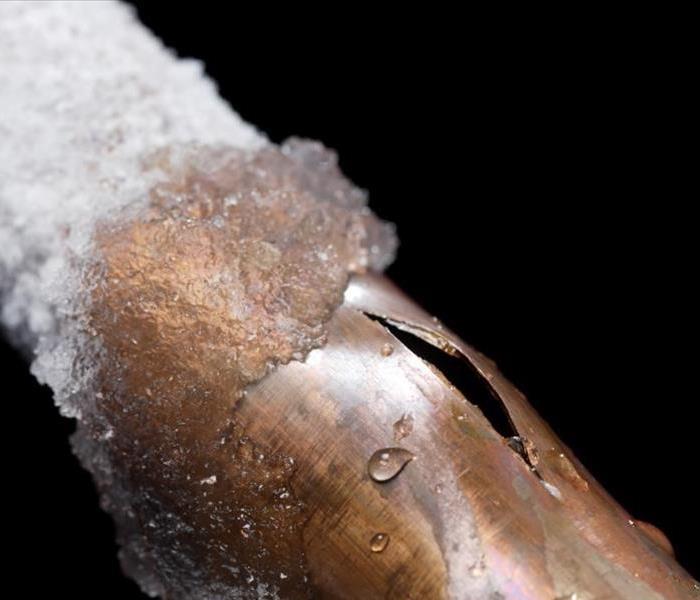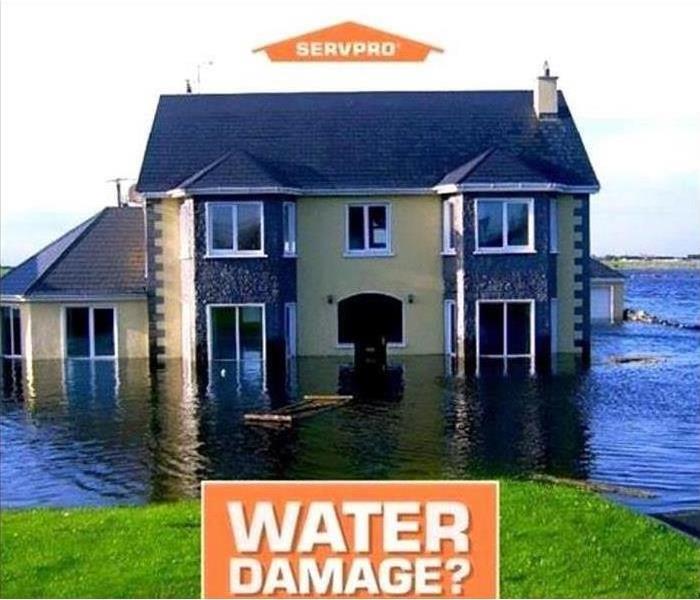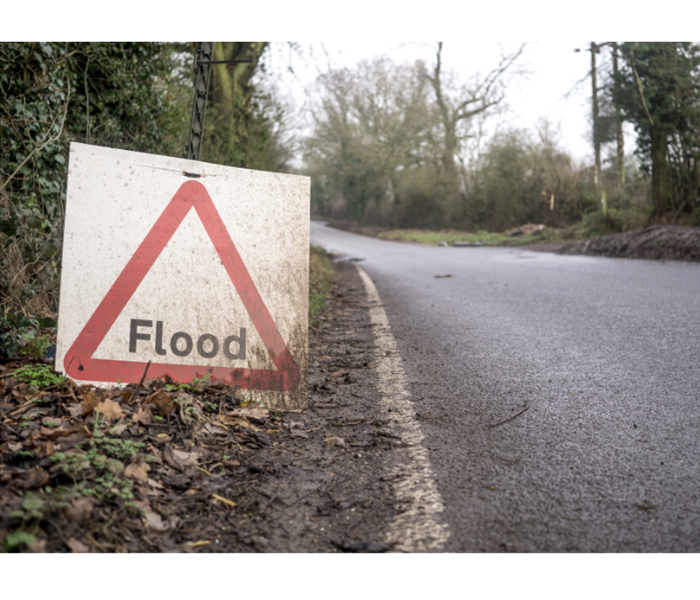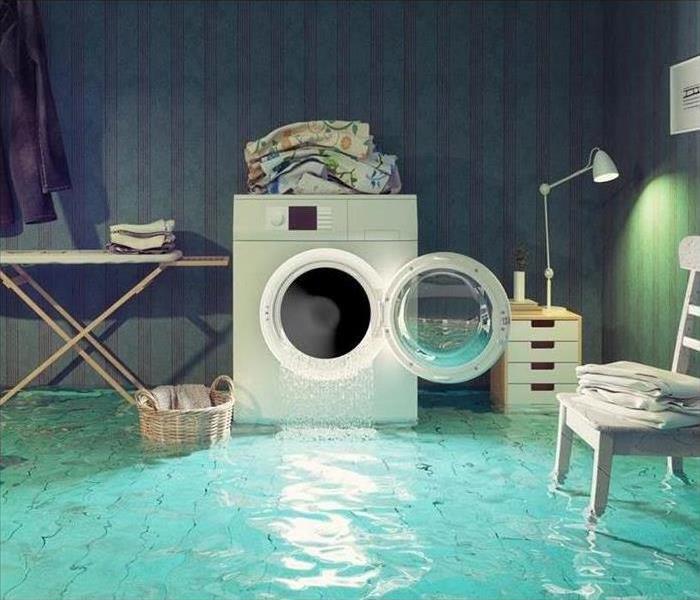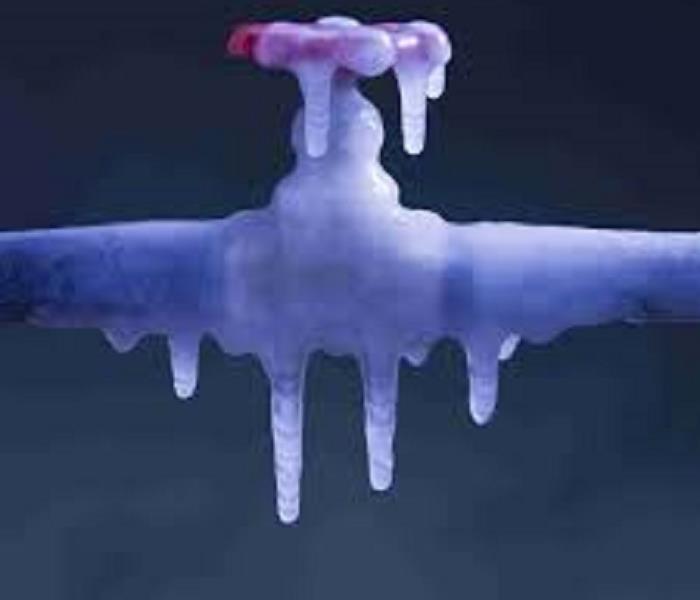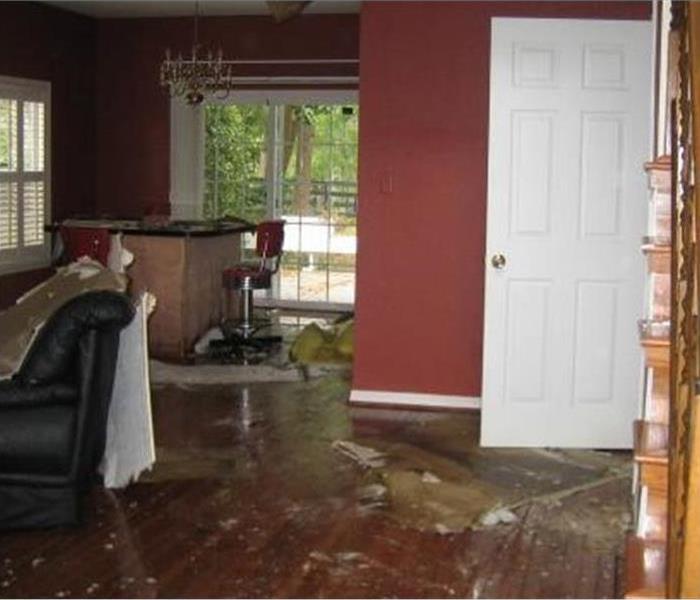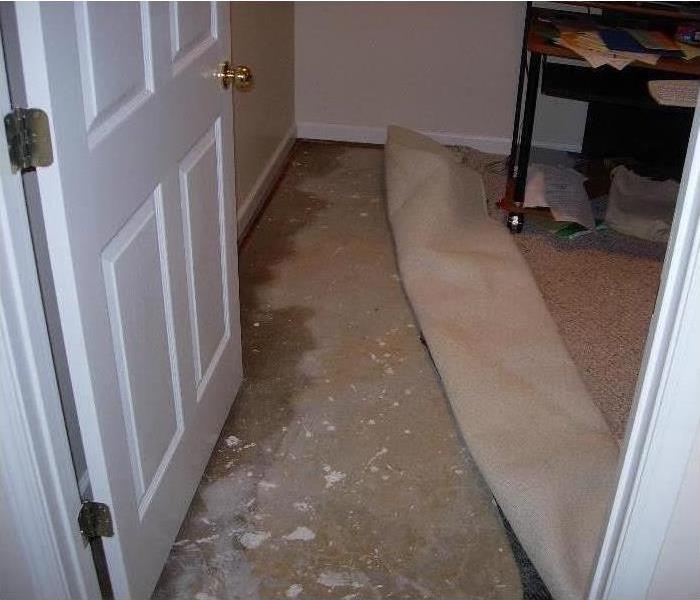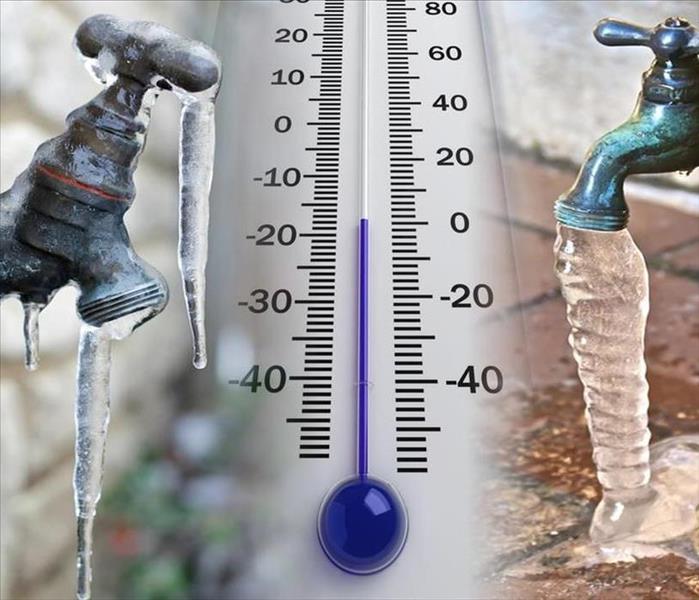Archived Water Damage Blog Posts
What You Should Know, Should You Experience A Water Damage.
6/20/2023 (Permalink)
The thing about water damage and repair professionals is that no one seems to have interest in knowing one until they're in desperate need of their help! We interviewed SERVPRO of Virginia Beach Franchise Owner, Anna Cheracles, to find out just what it is that a restoration professional does and when and why someone would need to hire one. Here's what Anna had to say:
What exactly does a water damage and repair professional do?
We arrive onsite within 4 hours (usually 1 hour) to remediate a water damage. The sooner you can stop the water and begin to dry the structure, the less damage you will have, which will reduce repairs that will need to be done.
Why is it important to call a professional?
We can restore vs. replace. We have special drying techniques which will save time and money for the insured and insurance company. You don't want to end up with any type of secondary damage or mold that could be prevented by calling a professional right away.
A professional will know when it is necessary to remove materials such as vinyl or laminate floors in order to dry sub floors. We have tools, such as moisture meters, that can detect exactly what's been affected so that we can properly mitigate the loss.
What are the most common problems water damage professionals see?
We often find pre-existing damage. It is important to properly maintain your home so that dry rot or other slow leaks do not occur. If you have a pipe burst under your sink, but you have dry rot already showing on you sub floor, often the insurance companies will not cover this due to the home not being maintained.
Another problem we see is when a homeowner does not take immediate action. They will wait a few days for the insurance company to come out before they call a mitigation company to come out. Or they try to do the work themselves. This will only prolong the process and possibly cause more damage later on. You need special equipment to properly dry a structure.
When should I call a water damage professional?
Anytime you experience a water damage, you should call a professional. The sooner you call, the more you can minimize damage. Even if the cause of the problem is still not fixed, the faster we can begin extracting water, you can lessen the chance of further damage. Often times an area can feel dry to the touch, but it is important to have a professional use a moisture meter to check for water behind cabinets, walls, etc. Dry wall may feel dry, but the insulation inside the wall could possibly be wet. Carpet could feel dry, but the sub floor and padding could have elevated moisture levels.
How much will it cost?
We use industry standard prices, which are set for each region in the country through a program called Xactimate. Most of the charges are done by square foot, by a labor hour or per piece of equipment. It is pricey to properly mitigate your home, but if you do it right the first time, you won't have mold grow and will save money in the long run. We deal directly with the insurance companies so there will not be any type of paperwork that you will need to file. We take care of it all!
What should I do while waiting?
If possible, turn the source of the water off. Begin mopping up water or blotting with towels. DO NOT use a shop vac to remove water. Shop vacs are not meant to extract a lot of water, only a little bit here and there. Put all furniture up on blocks, or even put foil under the legs of furniture to protect it and to also protect your carpet from getting any staining on it. You should also wipe up any water on wood furniture so it does not ruin it. Do not use electrical devices where the moisture is present. Make sure to not stand under any sagging ceilings.
How do I decide who to hire?
You should always try to hire someone who has a national reputation and a brand that stands behind them. Take advice from your insurance company, they work with these professionals everyday and should have a good recommendation.
When Water Strikes in Virginia Beach
10/13/2022 (Permalink)
When Water Strikes in Virginia Beach
If you are looking to prevent damage to your home, staying ahead of water damage is crucial. Water damage leads to rotted wood, insect infestation, peeling paint and weakened roofs and siding, Mold or Mildew
Check for leaks and cracks where water can enter, such as windows and doors, especially around corners. Clean and caulk these leaks immediately. Look for broken shingles and cracks in exterior walls. Repair or replace any broken shingles that are allowing water in, seal all cracks and holes in your home’s foundation, joints, and exterior walls. Ceiling leaks can be dealt with by measuring the location of the leak from the nearest outside wall, then locating this point in the attic with a measuring tape.
Check your home for leaking faucets, sweating pipes, bad drainage systems, and clogged drains—all of these can lead to water leaking, pooling, and causing damage. Keep an eye on your water heater for signs of leaking water or rust. If you have a wood home, look out for termite damage. To prevent future leaks, install flashing around doors, windows, thresholds, chimneys, and roofs—it prevents water from penetrating places where two different building surfaces meet.
Maybe you are just dealing with a burst pipe, or worse yet you have a flooded basement. Regardless of how bad the initial damage is, you cannot afford to wait to start the water cleanup process. Within just a single hour up to a day after your home has been exposed to water, it will begin to cause damage. This is when drywall begins to bulge and break, furniture begins to swell and crack, and metal surfaces begin to tarnish
Water spreads very quickly and will get absorbed into the floors, the walls, your furniture, and other areas in your home. Once you have stopped the actual leak, you need to immediately start the process of water mitigation, which is the process of preventing or reducing the amount of water damage, to prevent additional damage so time is of the essence. If water damage persists for more than a week, mildew and mold growth, structural damage and biohazard contaminants may pose serious risks to you and your family. The delay in restoration time may also significantly increase the cost to repair water damage.
Do not hesitate to call SERVPRO of Virginia Beach at 757-431-1400 we strive to make it “Like it never even happened.”
Preparing for winter weather and avoiding water damage from Frozen Pipes
10/6/2022 (Permalink)
As seasons change, so do property owners preparation checklists. With winter weather upon us, it is important for homeowners and property managers to do everything they can do to reduce risks of costly water damage caused by frozen pipes.
When water freezes, it expands. That’s why a can of soda explodes if it’s put into a freezer to chill quickly and then forgotten. When water freezes in a pipe, it expands the same way. If it expands enough, the pipe bursts and water escapes leaving serious damage as a result.
Pipes in attics, crawlspaces, and outside walls are all vulnerable to freezing, especially if there are cracks or openings that allow the cold, outside air to flow across the pipes. Holes in an outside wall where television, cable or telephone lines enter can provide access for cold air to reach pipes.
The Red Cross warns that pipe freezing is likely to occur after consecutive days and nights of freezing (32 degrees) or below conditions. Taking the following precautions ahead of time can help you prevent potential pipe catastrophes:
- Keep a slow trickle of water flowing through faucets, especially if the pipes for faucets run through unheated or uninsulated areas of your home. Allowing cold water to trickle from a faucet can alleviate pressure and prevent a rupture even if freezing occurs.
- If a vacant home, keep the temperature above 65 degrees.
- Cap outdoor water fixtures. By placing a cover on outdoor spigots and faucets, it reduces the possibility these fixtures build up with ice.
- Keep cabinet doors open during cold spells. This allows warm air to circulate around pipes.
If you have done nothing to prevent frozen pipes and you have water leaking or you have no water pressure, it likely means your pipes have burst. According to State Farm Insurance, this happens to more than 50 million families each year in the United States. If a pipe has even 1/8” crack, it can release 250 gallons of water a day.
You must act fast to prevent further, and more costly damage.
- This first step is to always shut down your property’s main water supply. (Depending on the amount of water and location, you may want to first turn off electricity.)
- If it’s heated water that’s coming from the broken pipe, you should also close the valve attached to your hot water heater.
- After you’ve shut down the water, call a plumber for help with repairing or replacing the burst pipe.
Make SERVPRO of Virginia Beach your first call to help you and your local insurance agent assess the damage. We will work for you to restore your property and your life to make it "Like it never even happened."
Flooding can happen ANYWHERE
5/3/2022 (Permalink)
It seems appropriate to write a little about flooding since we are smack in the middle of Hurricane Preparedness Week
According to the National Weather Service (NOAA), “Approximately seventy-five percent of all Presidential disaster declarations are associated with flooding.” NOAA lists the most common flood hazards in the United States as
- Flash Flooding
- River Flooding
- Storm Surge and Coastal Inundation from Tropical and Non-Tropical systems
- Burn Scars/Debris Flows (caused by wildfires)
- Ice/Debris Jams
- Snowmelt
- Dry Wash (caused by heavy rainfall in dry areas)
- Dam Breaks/Levee Failure
Just because you haven’t experienced a flood doesn’t mean you won’t in the future. In fact, 20% of all claims paid by the National Flood Insurance Program (NFIP) were for polices in the low-risk communities. On average, floods cost $3.5 billion in annual losses in the U.S., and commercial flood claims average more than $75,000 (NFIP).
When Catastrophic water damage (or any water damage) happens to you, SERVPRO of Virginia Beach professionals can help. It is always best to call SERVPRO of Virginia Beach directly at 757-544-6027
Water Damage Do's and Don'ts
4/4/2022 (Permalink)
Experiencing a water damage is no fun. The Key to avoiding costly future restoration is to handle every water problem as a real threat to your property. SERVPRO of Virginia Beach has the equipment, training, and experience to find and dry unseen water before secondary damages occur. When time matters, technology, and equipment and experience must be counted on to perform. Here are some Do’s and Don’ts to help you until help arrives.
STOP the source of water.
REMOVE as much excess water as possible by mopping or blotting.
WIPE excess water from wood furnishings after removing any contents lying on the surface.
Clearly designate wet area with floor signs and safety tape.
Pad or block wood furniture to prevent permanent staining of carpet.
Carefully remove colored items in affected areas, especially those in contact with carpet and upholstery
Remove and prop wet upholstery and pillow cushions for even drying
Isolate areas where sewer or black water exposure has occurred
Be aware of potential electrical hazards. DO NOT attempt to vacuum up water with standard vacuum equipment.
DO NOT turn on Ceiling fans or light fixtures is ceiling is wet. Avoid standing beneath sagging ceilings.
It is always best to rely on the professionals at SERVPRO of Virginia Beach. It is always best to call us directly at 757-431-1400
How To Prepare for Winter Weather, Avoid Frozen Pipes!
1/7/2022 (Permalink)
As seasons change, so do property owners preparation checklists. With winter weather upon us, it is important for homeowners and property managers to do everything they can do to reduce risks of costly water damage caused by frozen pipes.
When water freezes, it expands. That’s why a can of soda explodes if it’s put into a freezer to chill quickly and then forgotten. When water freezes in a pipe, it expands the same way. If it expands enough, the pipe bursts and water escapes leaving serious damage as a result.
Pipes in attics, crawlspaces, and outside walls are all vulnerable to freezing, especially if there are cracks or openings that allow the cold, outside air to flow across the pipes. Holes in an outside wall where television, cable or telephone lines enter can provide access for cold air to reach pipes.
The Red Cross warns that pipe freezing is likely to occur after consecutive days and nights of freezing (32 degrees) or below conditions. Taking the following precautions ahead of time can help you prevent potential pipe catastrophes:
- Keep a slow trickle of water flowing through faucets, especially if the pipes for faucets run through unheated or uninsulated areas of your home. Allowing cold water to trickle from a faucet can alleviate pressure and prevent a rupture even if freezing occurs.
- If a vacant home, keep the temperature above 65 degrees.
- Cap outdoor water fixtures. By placing a cover on outdoor spigots and faucets, it reduces the possibility these fixtures build up with ice.
- Keep cabinet doors open during cold spells. This allows warm air to circulate around pipes.
If you have done nothing to prevent frozen pipes and you have water leaking or you have no water pressure, it likely means your pipes have burst. According to State Farm Insurance, this happens to more than 50 million families each year in the United States. If a pipe has even 1/8” crack, it can release 250 gallons of water a day.
You must act fast to prevent further, and more costly damage.
- This first step is to always shut down your property’s main water supply. (Depending on the amount of water and location, you may want to first turn off electricity.)
- If it’s heated water that’s coming from the broken pipe, you should also close the valve attached to your hot water heater.
- After you’ve shut down the water, call a plumber for help with repairing or replacing the burst pipe.
Make SERVPRO of Virginia Beach your first call to help you and your local insurance agent assess the damage. We will work for you to restore your property and your life to make it "Like it never happened."
How to prepare for winter weather and avoid water damage from FROZEN PIPES.
12/8/2021 (Permalink)
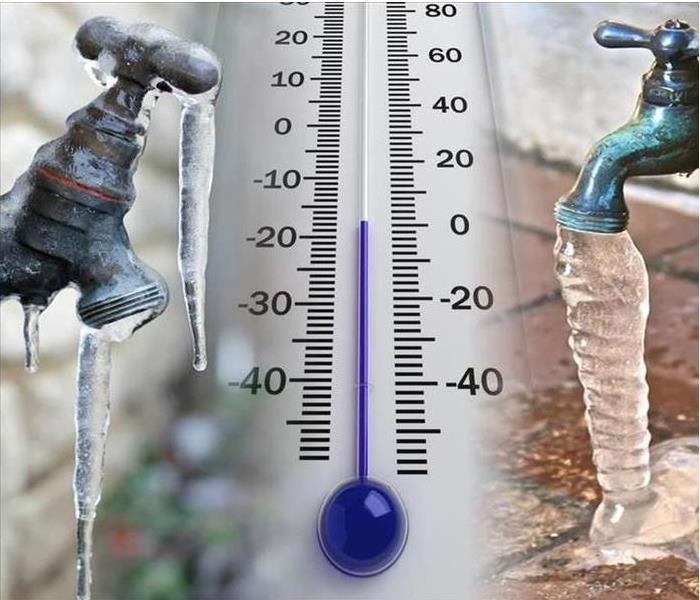 Winter weather worries
Winter weather worries
As seasons change, so do property owners preparation checklists. With winter weather upon us, it is important for homeowners and property managers to do everything they can do to reduce risks of costly water damage caused by frozen pipes.
When water freezes, it expands. That’s why a can of soda explodes if it’s put into a freezer to chill quickly and then forgotten. When water freezes in a pipe, it expands the same way. If it expands enough, the pipe bursts and water escapes leaving serious damage as a result.
Pipes in attics, crawlspaces, and outside walls are all vulnerable to freezing, especially if there are cracks or openings that allow the cold, outside air to flow across the pipes. Holes in an outside wall where television, cable or telephone lines enter can provide access for cold air to reach pipes.
The Red Cross warns that pipe freezing is likely to occur after consecutive days and nights of freezing (32 degrees) or below conditions. Taking the following precautions ahead of time can help you prevent potential pipe catastrophes:
- Keep a slow trickle of water flowing through faucets, especially if the pipes for faucets run through unheated or uninsulated areas of your home. Allowing cold water to trickle from a faucet can alleviate pressure and prevent a rupture even if freezing occurs.
- If a vacant home, keep the temperature above 65 degrees.
- Cap outdoor water fixtures. By placing a cover on outdoor spigots and faucets, it reduces the possibility these fixtures build up with ice.
- Keep cabinet doors open during cold spells. This allows warm air to circulate around pipes.
If you have done nothing to prevent frozen pipes and you have water leaking or you have no water pressure, it likely means your pipes have burst. According to State Farm Insurance, this happens to more than 50 million families each year in the United States. If a pipe has even 1/8” crack, it can release 250 gallons of water a day.
You must act fast to prevent further, and more costly damage.
- This first step is to always shut down your property’s main water supply. (Depending on the amount of water and location, you may want to first turn off electricity.)
- If it’s heated water that’s coming from the broken pipe, you should also close the valve attached to your hot water heater.
- After you’ve shut down the water, call a plumber for help with repairing or replacing the burst pipe.
Make SERVPRO of Virginia Beach your first call to help you and your local insurance agent assess the damage. We will work for you to restore your property and your life to make it "Like it never even happened."
When Water Strikes in Virginia Beach
10/14/2021 (Permalink)
When Water Strikes in Virginia Beach
If you are looking to prevent damage to your home, staying ahead of water damage is crucial. Water damage leads to rotted wood, insect infestation, peeling paint and weakened roofs and siding, Mold or Mildew
Check for leaks and cracks where water can enter, such as windows and doors, especially around corners. Clean and caulk these leaks immediately. Look for broken shingles and cracks in exterior walls. Repair or replace any broken shingles that are allowing water in, seal all cracks and holes in your home’s foundation, joints, and exterior walls. Ceiling leaks can be dealt with by measuring the location of the leak from the nearest outside wall, then locating this point in the attic with a measuring tape.
Check your home for leaking faucets, sweating pipes, bad drainage systems, and clogged drains—all of these can lead to water leaking, pooling, and causing damage. Keep an eye on your water heater for signs of leaking water or rust. If you have a wood home, look out for termite damage. To prevent future leaks, install flashing around doors, windows, thresholds, chimneys, and roofs—it prevents water from penetrating places where two different building surfaces meet.
Maybe you are just dealing with a burst pipe, or worse yet you have a flooded basement. Regardless of how bad the initial damage is, you cannot afford to wait to start the water cleanup process. Within just a single hour up to a day after your home has been exposed to water, it will begin to cause damage. This is when drywall begins to bulge and break, furniture begins to swell and crack, and metal surfaces begin to tarnish
Water spreads very quickly and will get absorbed into the floors, the walls, your furniture, and other areas in your home. Once you have stopped the actual leak, you need to immediately start the process of water mitigation, which is the process of preventing or reducing the amount of water damage, to prevent additional damage so time is of the essence. If water damage persists for more than a week, mildew and mold growth, structural damage and biohazard contaminants may pose serious risks to you and your family. The delay in restoration time may also significantly increase the cost to repair water damage.
Do not hesitate to call SERVPRO of Virginia Beach at 757-431-1400 we strive to make it “Like it never even happened.”
It's the water you don't see that can be scary
10/8/2021 (Permalink)
It's The Water You Don't See...
Even small water damages have the potential to cause serious structural and indoor air quality issues over time.
The key to avoiding costly future restoration is to handle every water problem as a real threat to your property. The proper equipment makes a measurable difference in reducing the damage expense during a water loss. When time matters most, technology and equipment must be counted on to perform.
Here are a few tools used by Professional Restoration Contractors to properly mitigate a loss.
Moisture Sensors- used to detect moisture in carpets, baseboards, and walls.
Moisture Meters- used to determine the actual moisture content of various materials. The meter provides accurate readings to monitor the drying process.
Thermohydrometers- measures temperature and relative humidity to calculate and create an environment most conducive to drying. When handling a contaminated loss (CAT 2 or 3), it is not only important to dry the structure, but disinfect and often deodorize.
Ultra-Low-Volume (ULV) Foggers- used to atomize liquid deodorizing agents, producing a fine mist that can easily penetrate the site where odor-causing residues may accumulate. It can also be used to inject fungicides and disinfectants into wall cavities and other hard-to-reach areas.
Thermal Foggers- dispenses solvent-based products by creating a dense fog that consists of tiny particles of deodorant solution that attach to and neutralize odor causing particles.
The bottom line... ALWAYS treat a water damage seriously. Call a professional contractor that is trained and experienced in property damage restoration.
Call SERVPRO of Virginia Beach for any restoration needs you may have at 757-431-1400.
Hurricane Preparedness
5/6/2021 (Permalink)
Hurricane season 2021 is predicted to be busier than normal, according to a forecast released from Colorado State University on Thursday.
CSU predicts 17 named storms, eight hurricanes, and four major hurricanes for the 2021 Atlantic season. This would be above the normal of 12 named storms, six hurricanes, and three major hurricanes. SERVPRO of Virginia Beach is urging everyone to “Resolve to be Ready” in 2021. Hurricane season starts June 1st and runs through November 30th. Now is the perfect time to think about making some preparations.
Preparing in advance to deal with the unexpected can make a world of difference in how quickly and completely we can put the pieces of their lives back together. We encourage all realtors, association managers and property owners to take advantage of the no-cost emergency planning tools available from the Federal Emergency Management Agency (FEMA) (www.ready.gov/publications)
Flood Insurance
The most important thing to consider for your home is flood insurance. A common misconception is that homes that are not in a flood zone are not eligible for such coverage. That is not the case. Any home can have a flood insurance policy. Insurance is sold through local agents as part of the National Flood Insurance Program, or NFIP. Homeowners can take out separate polices to insure the structure and any contents inside. Homes that are in a designated flood zone are required to have flood insurance, and it is typically a stipulation during the sale of a house. In fact, it is recommended that homes outside of a flood zone also have coverage, especially in coastal communities, like Hampton Roads. Nationally, about 30 % of flood insurance claims come from homes that are not in a flood zone. Premiums vary by numerous factors such as location, age of the dwelling and value of insured contents inside the home. For more information about the NFIP, please visit FEMA.gov/NFIP.
Know your Zone.
The state introduced “Know Your Zone” to simplify evacuation processes when it becomes necessary. There are four zones, lettered A-D, that specify your evacuation zone based on your address and nature of the emergency event. State and local agencies will alert residents by their zones if there is a need to evacuate or shelter in place. While not every neighborhood is in a zone, that does not mean you will never have to evacuate, so you’ll still need to pay attention to official announcements and news.
To find your zone, go to KnowYourZoneVA.org. Once there, follow the on-screen instructions to enter your address and determine where you fall on the map.
Know your way out.
Have an evacuation plan, become familiar with it and make sure your family is aware of it as well. The most common routes:
- If you live north of I-264, head north and west along I-64 and across the HRBT and move inland.
- If you live south of I-264, head south and west on I-64 towards Suffolk and Highway 460 Continue to head inland and away from the coast to lessen the impact of a storm.
Keep in mind that the Chesapeake Bay Bridge Tunnel will likely be closed if an incoming storm has high winds. Avoid going north on Highway 13 and opt for the other routes.
If you choose to Shelter in Place
Have a cache of supplies that will last each member of your household, including any pets or infants, at least three days. Some of the basic supplies are:
- Water – one gallon per person, per day
- Food – Non-perishable or canned goods
- Medications and first-aid supplies
- Portable lights and batteries
- Portable radio
- Personal hygiene supplies
- Toilet paper
- Cash – to purchase one week’s worth of supplies for your household.
Should you or someone you know experience a water damage from a hurricane or a leaking pipe please do not hesitate to call SERVPRO of Virginia Beach at 757-431-1400
Virginia Beach: Your Mop is NOT Qualified
4/8/2021 (Permalink)
We know how disruptive unseen water damage can be for your home or business. For this reason, SERVPRO of Virginia Beach offers 24-hour emergency response services. We understand how to manage the drying process and use the proper equipment and moisture measuring devices. We ensure your home or building is quickly and thoroughly dried. This helps prevent secondary water damage and allows you to regain control quickly, ensuring your structure and its contents are properly dried, deodorized and protected.
So, before you risk further damaging the value of your home or business by attempting to clean up the mess yourself, call SERVPRO of Virginia Beach and let us make it "Like it never even happened."
Give us a call directly at 757-431-1400.
Don't know what to do if you experience a water damage? We asked an Expert, Anna Chercles, Owner of SERVPRO of Virginia beach.
1/11/2021 (Permalink)
The thing about water damage and repair professionals is that no one seems to have interest in knowing one until they are in desperate need of their help! We interviewed SERVPRO of Virginia Beach Franchise Owner, Anna Cheracles, to find out just what it is that a restoration professional does and when and why someone would need to hire one. Here is what Anna had to say:
What exactly does a water damage and repair professional do?
We arrive onsite within 4 hours (usually 1 hour) to remediate a water damage. The sooner you can stop the water and begin to dry the structure, the less damage you will have, which will reduce repairs that will need to be done.
Why is it important to call a professional?
We believe in restore vs. replace. We have special drying techniques which will save time and money for the insured and insurance company. You do not want to end up with any type of secondary damage or mold that could be prevented by calling a professional right away.
A professional will know when it is necessary to remove materials such as vinyl or laminate floors in order to dry sub floors. We have tools, such as moisture meters, that can detect exactly what's been affected so that we can properly mitigate the loss.
What are the most common problems water damage professionals see?
We often find pre-existing damage. It is important to properly maintain your home so that dry rot or other slow leaks do not occur. If you have a pipe burst under your sink, but you have dry rot already showing on you sub floor, often the insurance companies will not cover this due to the home not being maintained.
Another problem we see is when a homeowner does not take immediate action. They will wait a few days for the insurance company to come out before they call a mitigation company to come out. Or they try to do the work themselves. This will only prolong the process and possibly cause more damage later. You need special equipment to properly dry a structure.
When should I call a water damage professional?
You should call a professional Anytime you experience a water damage. The sooner you call, the more you can minimize damage. Even if the cause of the problem is still not fixed, the faster we can begin extracting water, you can lessen the chance of further damage. Often an area can feel dry to the touch, but it is important to have a professional use a moisture meter to check for water behind cabinets, walls, etc. Dry wall may feel dry, but the insulation inside the wall could possibly be wet. Carpet could feel dry, but the sub floor and padding could have elevated moisture levels.
How much will it cost?
We use industry standard prices, which are set for each region in the country through a program called Xactimate. Most of the charges are done by square foot, by a labor hour or per piece of equipment. It is pricey to properly mitigate your home, but if you do it right the first time, you won't have mold grow and will save money in the long run. We deal directly with the insurance companies so there will not be any type of paperwork that you will need to file. We take care of it all!
What should be done while waiting?
If possible, turn the source of the water off. Begin mopping up water or blotting with towels. DO NOT use a shop vac to remove water. Shop vacs are not meant to extract a lot of water, only a little bit here and there. Put all furniture up on blocks, or even put foil under the legs of furniture to protect it and to also protect your carpet from getting any staining on it. You should also wipe up any water on wood furniture, so it does not ruin it. Do not use electrical devices where the moisture is present. Make sure to not stand under any sagging ceilings.
How do I decide who to hire?
You should always try to hire someone who has a national reputation and a brand that stands behind them.
Should you require a professional, call, SERVPRO of Virginia Beach
When Water Strikes in Virginia Beach
12/14/2020 (Permalink)
When Water Strikes in Virginia Beach
If you are looking to prevent damage to your home, staying ahead of water damage is crucial. Water damage leads to rotted wood, insect infestation, peeling paint and weakened roofs and siding, Mold or Mildew
Check for leaks and cracks where water can enter, such as windows and doors, especially around corners. Clean and caulk these leaks immediately. Look for broken shingles and cracks in exterior walls. Repair or replace any broken shingles that are allowing water in, seal all cracks and holes in your home’s foundation, joints, and exterior walls. Ceiling leaks can be dealt with by measuring the location of the leak from the nearest outside wall, then locating this point in the attic with a measuring tape.
Check your home for leaking faucets, sweating pipes, bad drainage systems, and clogged drains—all of these can lead to water leaking, pooling, and causing damage. Keep an eye on your water heater for signs of leaking water or rust. If you have a wood home, look out for termite damage. To prevent future leaks, install flashing around doors, windows, thresholds, chimneys, and roofs—it prevents water from penetrating places where two different building surfaces meet.
Maybe you are just dealing with a burst pipe, or worse yet you have a flooded basement. Regardless of how bad the initial damage is, you cannot afford to wait to start the water cleanup process. Within just a single hour up to a day after your home has been exposed to water, it will begin to cause damage. This is when drywall begins to bulge and break, furniture begins to swell and crack, and metal surfaces begin to tarnish
Water spreads very quickly and will get absorbed into the floors, the walls, your furniture, and other areas in your home. Once you have stopped the actual leak, you need to immediately start the process of water mitigation, which is the process of preventing or reducing the amount of water damage, to prevent additional damage so time is of the essence. If water damage persists for more than a week, mildew and mold growth, structural damage and biohazard contaminants may pose serious risks to you and your family. The delay in restoration time may also significantly increase the cost to repair water damage.
Do not hesitate to call SERVPRO of Virginia Beach at 757-431-1400 we strive to make it “Like it never even happened.”
Tips for Dealing with Water Damage in Virginia Beach
10/14/2020 (Permalink)
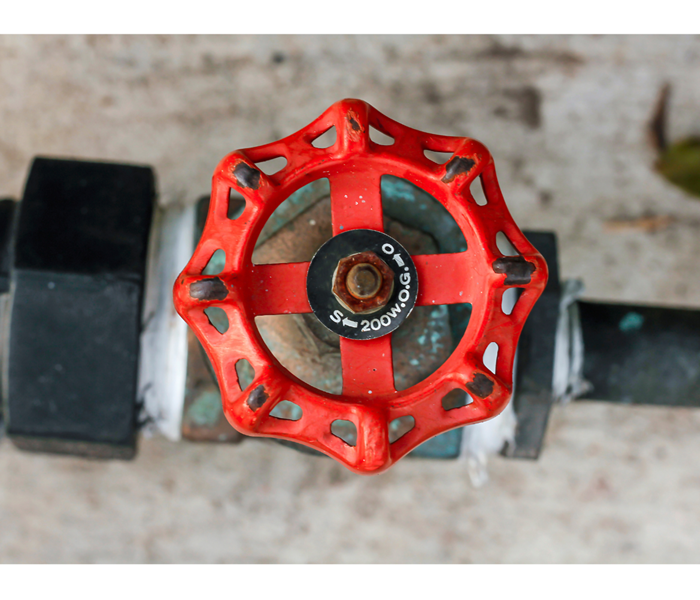 Know where your main water shut off is located
Know where your main water shut off is located
Water damage should always be taken seriously. Even if your home in Virginia Beach experiences a minor leak from a leaky faucet or broken pipes, water has a way of spreading into walls, floors, and other hidden areas. To ensure the damage doesn’t spread, trust a water damage expert to get your home back to new. While you wait for help to arrive, below are a few tips to help contain the damage.
Shut Off the Water Source and Electricity
Safety should always come first. If the water is coming from a pipe, turning off the main water source is imperative since mold can start growing within hours. Depending on where the damage occurs, turn off the electricity.
Check for Mold and Mildew
A main issue resulting from water damage is the growth of mildew and mold. These spores quickly grow and spread, even to areas in the home that aren’t affected by the water. If left unchecked, it can create more serious issues down the road.
Eradicate the Moisture
Water mitigation is an essential part of getting your home back to normal. Along with removing excess water, use fans and dehumidifiers to circulate the air and assist with evaporation. However, if you have visible mold, you should refrain from the use of fans to avoid further spread.
Remove Affected Porous Materials
Water can shrink and warp porous materials. All effected carpeting, insulation, fabrics, paper and other items should be removed from the area. Along with helping the damaged area dry out, removing these items could potentially save them from having to be disposed of.
Disinfect
Once items have been removed and the damaged area is dry, it’s time for some deep cleaning. Any hard surfaces that were touched by water should be disinfected. This will help reduce the chances of mold spreading.
Dealing with water damage is not a fun job, but not addressing early it will make it a much bigger job. While these steps can help reduce the spread of damage, calling the professionals at SERVPRO of Virginia Beach can make it “Like it never even happened.”
Flood Safety Tips for Virginia Beach
10/9/2020 (Permalink)
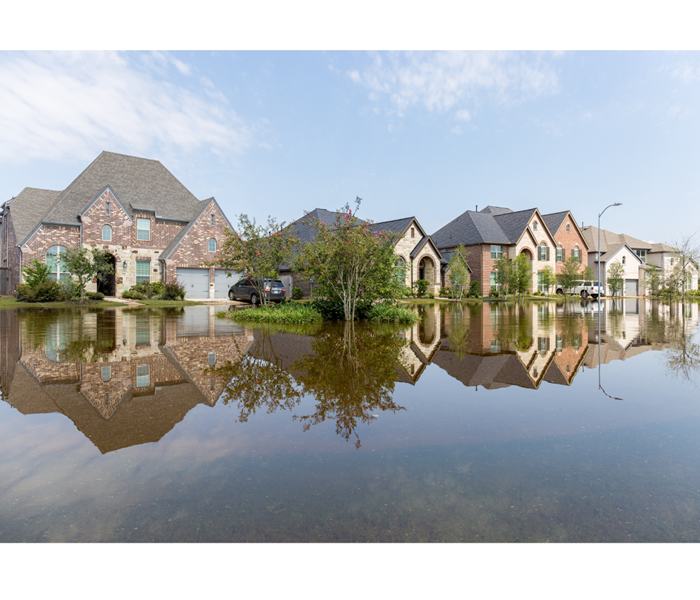 Devastating flood effects
Devastating flood effects
Hurricane Season runs from June 1st to November 30th. Although we are nearing the end of hurricane season, it is still beneficial for everyone to be prepared and aware of impacts that come along with natural disasters.
It is very important that homeowners are aware of the possibilities of damaging winds and overflowing rainwater and have an action plan in place so they can act quickly if and when necessary. Here are four helpful tips:
1- The safety of the homeowner and their family should be first priority. They should know how to leave their home safely, so having an evacuation plan is essential.
2- Make an Evacuation Kit. Each kit will vary Depending on the specific storm you are facing, however the basics of each kit should include items like flashlights, canned food, water, radio, batteries and any necessary medication.
3- If evacuation is necessary stay away from flooded streets.
4- Have a clean up plan. After the water resides and you feel it is safe to re-enter your home, It is imperative that you call a professional to verify that the contamination caused by the flooding is completely out of your home.
SERVPRO of Virginia Beach offers 24- hour emergency response services. We are fully trained and understand how to manage the drying process and use the proper equipment and moisture measuring devices. This prevents secondary water damage and insures that your home is quickly and thoroughly dried.
call SERVPRO of Virginia Beach during your time of need and let us make it "Like it never even happened." 757-431-1400
SERVPRO of Virginia Beach owner explains when and why you should hire a professional after water damage
5/14/2020 (Permalink)
 Water damage have can long term effects on your home
Water damage have can long term effects on your home
The thing about water damage and repair professionals is that no one seems to have interest in knowing one until they're in desperate need of their help! We interviewed SERVPRO of Virginia Beach Franchise Owner, Anna Cheracles, to find out just what it is that a restoration professional does and when and why someone would need to hire one. Here's what Anna had to say:
What exactly does a water damage and repair professional do?
We arrive onsite within 4 hours (usually 1 hour) to remediate a water damage. The sooner you can stop the water and begin to dry the structure, the less damage you will have, which will reduce repairs that will need to be done.
Why is it important to call a professional?
We can restore vs. replace. We have special drying techniques which will save time and money for the insured and insurance company. You don't want to end up with any type of secondary damage or mold that could be prevented by calling a professional right away.
A professional will know when it is necessary to remove materials such as vinyl or laminate floors in order to dry sub floors. We have tools, such as moisture meters, that can detect exactly what's been affected so that we can properly mitigate the loss.
What are the most common problems water damage professionals see?
We often find pre-existing damage. It is important to properly maintain your home so that dry rot or other slow leaks do not occur. If you have a pipe burst under your sink, but you have dry rot already showing on you sub floor, often the insurance companies will not cover this due to the home not being maintained.
Another problem we see is when a homeowner does not take immediate action. They will wait a few days for the insurance company to come out before they call a mitigation company to come out. Or they try to do the work themselves. This will only prolong the process and possibly cause more damage later on. You need special equipment to properly dry a structure.
When should I call a water damage professional?
Anytime you experience a water damage, you should call a professional. The sooner you call, the more you can minimize damage. Even if the cause of the problem is still not fixed, the faster we can begin extracting water, you can lessen the chance of further damage. Often times an area can feel dry to the touch, but it is important to have a professional use a moisture meter to check for water behind cabinets, walls, etc. Dry wall may feel dry, but the insulation inside the wall could possibly be wet. Carpet could feel dry, but the sub floor and padding could have elevated moisture levels.
How much will it cost?
We use industry standard prices, which are set for each region in the country through a program called Xactimate. Most of the charges are done by square foot, by a labor hour or per piece of equipment. It is pricey to properly mitigate your home, but if you do it right the first time, you won't have mold grow and will save money in the long run. We deal directly with the insurance companies so there will not be any type of paperwork that you will need to file. We take care of it all!
What should I do while waiting?
If possible, turn the source of the water off. Begin mopping up water or blotting with towels. DO NOT use a shop vac to remove water. Shop vacs are not meant to extract a lot of water, only a little bit here and there. Put all furniture up on blocks, or even put foil under the legs of furniture to protect it and to also protect your carpet from getting any staining on it. You should also wipe up any water on wood furniture so it does not ruin it. Do not use electrical devices where the moisture is present. Make sure to not stand under any sagging ceilings.
How do I decide who to hire?
You should always try to hire someone who has a national reputation and a brand that stands behind them. Take advice from your insurance company, they work with these professionals everyday and should have a good recommendation.
When Water Damage Strikes in Virginia Beach
4/24/2020 (Permalink)
The first 24 hours following a water loss are the most important in preventing secondary or permanent damage. Within four hours of receiving a loss notification, SERVPRO of Virginia Beach professionals will be on-site to help ensure a water damage is handled by completing the following steps.
INSPECTION – SERVPRO of Virginia Beach will inspect affected areas to determine the extent of water damage and will review the inspection with you to answer any questions before beginning the work.
EMERGENCY SERVICES – SERVPRO of Virginia Beach will take steps to help protect your home or business, as well as personal property and other contents, from further damage by extracting the excess water and preparing the area for drying. They will explain the needed emergency services to you step-by-step.
MONITORING – To help ensure your home or business and belongings are dried to appropriate industry standards, a SERVPRO of Virginia Beach professional will monitor the drying process. The updates will be consistently communicated with you.
RESTORATION SERVICES – SERVPRO of Virginia Beach will repair structural materials, reinstall carpets and clean affected areas of your property and contents. A final walk-through of the jobsite will be conducted with you to help ensure the property was returned to its preloss condition.
EMERGENCY WATER DAMAGE TIPS:
- Shut off the water source, if possible, or contact a qualified professional to stop the water source
- Turn off circuit breakers for wet areas of the building when access to the power distribution panel is safe from electrical shock
- Remove as much excess water as possible by mopping and blotting
- Place aluminum foil or wood blocks between furniture legs and wet carpeting
- Move any paintings, art objects, computers, documents and other sensitive valuables to a dry place
- Do not enter affected areas if electrical outlets, switches, circuit breakers or electrical equipment are exposed to water to avoid electrical shock hazards
- Do not use your household vacuum cleaner to remove water – this could cause electrical shock or damage to the device
- Do not turn on ceiling fixtures if the ceiling is wet or enter rooms where ceilings are sagging from retained water
For more information on recovering from water damage, contact SERVPRO of Virginia Beach at 757-431-1400.
It's the Water you Don't See
1/13/2020 (Permalink)
It's The Water You Don't See...
Even small water damages have the potential to cause serious structural and indoor air quality issues over time.
The key to avoiding costly future restoration is to handle every water problem as a real threat to your property. The proper equipment makes a measurable difference in reducing the damage expense during a water loss. When time matters most, technology and equipment must be counted on to perform.
Here are a few tools used by Professional Restoration Contractors to properly mitigate a loss;
Moisture Sensors- used to detect moisture in carpets, baseboards and walls.
Moisture Meters- used to determine the actual moisture content of various materials. The meter provides accurate readings to monitor the drying process.
Thermo Hygrometers- measures temperature and relative humidity to calculate and create an environment most conducive to drying. When handling a contaminated loss (CAT 2 or 3), it is not only important to dry the structure, but disinfect and deodorize.
Ultra Low-Volume (ULV) Foggers- used to atomize liquid deodorizing agents, producing a fine mist that can easily penetrate the site where odor-causing residues may accumulate. It can also be used to inject fungicides and disinfectants into wall cavities and other hard-to-reach areas.
Thermal Foggers- dispenses solvent-based products by creating a dense fog that consists of tiny particles of deodorant solution that attach to and neutralize odor causing particles.
The bottom line... ALWAYS treat water damage seriously. Call in a professional team like SERVPRO of Virginia Beach. We will work for you to restore your property and your life to make it "Like it never even happened."
Frozen Pipe Season
1/2/2020 (Permalink)
Frozen pipe season is upon us. If you live in an older home, the risk of encountering frozen pipes is increased. However, it can happen to anyone because when water freezes, it expands and non-insulated pipes are more likely to burst or leak. A burst pipe can cause extraordinary damage if not handled immediately so in order to prevent pipes from freezing here are a few steps that you as a homeowner can take according to The American Red Cross:
- Be sure to completely drain water from sprinkler lines as well as outside hoses
- Open all of your kitchen cabinets to let warm air circulate around the plumbing
- Let water drip from your faucets
- Keep your heat set to the same temperature both day and night
SERVPRO of Virginia Beach professionals are available 24-hours a day, 365 days a year. Call us if your pipes freeze this winter and we will make it “Like it never even happened." 757-431-1400
Flood Safety Tips
10/16/2019 (Permalink)
Though we’re nearing the end of hurricane season it still proves beneficial for homeowners to be prepared and aware of all the troubles that comes along with natural disasters.
Hurricane season runs from June 1st to November 30th, during that span of time homeowners could find themselves falling victim to damaging winds and an overflow of rainwater. It is prudent that homeowners are aware of these possibilities and put an action plan into place so that they are able to act fast if and when necessary. Here are a few helpful tips for homeowners everywhere.
- Have an Evacuation Plan - The safety of the homeowner and their family should be first priority. Homeowners should know how to safely leave their home in these circumstances. Homeowners should create a safety plan with their families and practice said plan ahead of the storm.
- Make and Evacuation Kit - Each kit can vary depending on the storm you’re facing, however certain items should always be in an evacuation kit. Items like a flashlight, canned food, water, radios and batteries.
- Stay Away From Pools of Water - If evacuation is necessary for you and your family stray away from flooded streets. Shallow water could also be full of debris that could cause damage your motor vehicle as well as you and your family.
- Have a Cleanup Plan - Even after the water resides and you deem it safe to re-enter your home, it is important that you call a professional to verify the harmful debris and contamination caused by the flooding is completely out.
SERVPRO of Virginia Beach offers 24-hour emergency response services. We understand how to manage the drying process and use the proper equipment and moisture measuring devices. We ensure your home is quickly and thoroughly dried. This helps prevent secondary water damage and allows you to regain control quickly, ensuring your structure and its contents are properly dried, deodorized and protected.
Call SERVPRO of Virginia Beach during your time of need and let us make it "Like it never even happened."
Ways to Spot Frozen Pipes
10/11/2019 (Permalink)
As the weather begins to transition into the colder months there are certain precautions homeowners should begin to take to keep their home safe under freezing conditions.
One of the most common headaches homeowners face during the colder months are frozen pipes.
Have you ever placed a can of soda in the freezer and simply just forgot about it and by the time you realized you forgot the can has already exploded making a mess of your freezer? Well, when water freezes in a pipe, it expands in the same way. If it expands enough, the pipe bursts and water escapes leaving serious damage as a result.
Pipes in attics, crawlspaces, and outside walls are all vulnerable to freezing, especially if there are cracks or openings that allow cold, outside air to flow across the pipes. Holes in an outside wall where television, cable or telephone lines enter can provide access for cold air to reach pipes.
Pipes tend to freeze after consecutive days and nights of freezing (32degrees Fahrenheit) and below freezing temperatures.
Frozen pipes should cause many homeowners concern, for bigger issues may and will arise. If you are unaware of the status of your pipes or what are some clues of a frozen pipe here’s a few signs that may help you.
- A slow stream of water, or no water at all coming through.
- Visible frost on your pipes
- Unusual loud sounds coming from your faucets
- Strange odors coming from your faucets
If any of these signs appear then it likely means your pipes have burst. If this is true, you must act fast, a few things you can do to prevent any further damage.
- This first step is to always shut down your property’s main water supply. (Depending on the amount of water and location, you may want to first turn off electricity.)
- If it’s heated water that’s coming from the broken pipe, you should also close the valve attached to your hot water heater.
- After you’ve shut down the water, call a plumber for help with repairing or replacing the burst pipe.
During this time of need, make SERVPRO of Virginia Beach your first call to help you and your local insurance agent assess the damage. We will work for you to restore your property and your life to make it "Like it never even happened."
SERVPRO of Virginia Beach Owner Explains When and Why You Should Hire a Professional After a Water Damage
5/14/2019 (Permalink)
The thing about water damage and repair professionals is that no one seems to have interest in knowing one until they're in desperate need of their help! We interviewed SERVPRO of Virginia Beach Franchise Owner, Anna Cheracles, to find out just what it is that a restoration professional does and when and why someone would need to hire one. Here's what Anna had to say:
What exactly does a water damage and repair professional do?
We arrive onsite within 4 hours (usually 1 hour) to remediate a water damage. The sooner you can stop the water and begin to dry the structure, the less damage you will have, which will reduce repairs that will need to be done.
Why is it important to call a professional?
We can restore vs. replace. We have special drying techniques which will save time and money for the insured and insurance company. You don't want to end up with any type of secondary damage or mold that could be prevented by calling a professional right away.
A professional will know when it is necessary to remove materials such as vinyl or laminate floors in order to dry sub floors. We have tools, such as moisture meters, that can detect exactly what's been affected so that we can properly mitigate the loss.
What are the most common problems water damage professionals see?
We often find pre-existing damage. It is important to properly maintain your home so that dry rot or other slow leaks do not occur. If you have a pipe burst under your sink, but you have dry rot already showing on you sub floor, often the insurance companies will not cover this due to the home not being maintained.
Another problem we see is when a homeowner does not take immediate action. They will wait a few days for the insurance company to come out before they call a mitigation company to come out. Or they try to do the work themselves. This will only prolong the process and possibly cause more damage later on. You need special equipment to properly dry a structure.
When should I call a water damage professional?
Anytime you experience a water damage, you should call a professional. The sooner you call, the more you can minimize damage. Even if the cause of the problem is still not fixed, the faster we can begin extracting water, you can lessen the chance of further damage. Often times an area can feel dry to the touch, but it is important to have a professional use a moisture meter to check for water behind cabinets, walls, etc. Dry wall may feel dry, but the insulation inside the wall could possibly be wet. Carpet could feel dry, but the sub floor and padding could have elevated moisture levels.
How much will it cost?
We use industry standard prices, which are set for each region in the country through a program called Xactimate. Most of the charges are done by square foot, by a labor hour or per piece of equipment. It is pricey to properly mitigate your home, but if you do it right the first time, you won't have mold grow and will save money in the long run. We deal directly with the insurance companies so there will not be any type of paperwork that you will need to file. We take care of it all!
What should I do while waiting?
If possible, turn the source of the water off. Begin mopping up water or blotting with towels. DO NOT use a shop vac to remove water. Shop vacs are not meant to extract a lot of water, only a little bit here and there. Put all furniture up on blocks, or even put foil under the legs of furniture to protect it and to also protect your carpet from getting any staining on it. You should also wipe up any water on wood furniture so it does not ruin it. Do not use electrical devices where the moisture is present. Make sure to not stand under any sagging ceilings.
How do I decide who to hire?
You should always try to hire someone who has a national reputation and a brand that stands behind them. Take advice from your insurance company, they work with these professionals everyday and should have a good recommendation.
Be Flood Smart in Virginia Beach
4/25/2019 (Permalink)
Floods are one of the most common and widespread natural disasters in the United States. Here in Virginia Beach, most of us have had to deal with flooded streets, yards and neighborhoods at one time. Whether your home or business is in a flood zone or not, there is always potential for flood damage. Flooding can occur near a coastline like in the Hampton Roads area, along city streets, in the mountains, near a river or even in the desert. Floodsmart.gov reports that in the last five years, all 50 states have experiences floods or flash floods.
Here are a few important tips from the American Red Cross to always follow:
- Stay away from floodwaters. If you come up on a flowing stream where water is above your ankles, stop, turn around and go another way. Six inches of swiftly moving water can sweep you off your feet.
- If you approach a flooded road while driving, turn around and go another way. If you are caught on a flooded road and waters are rising rapidly around you, get out of the car quickly and move to higher ground. Most cars can be swept away by less than two feet of moving water.
- Keep children out of the water. They are curious and often lack judgment about running or contaminated water.
If a flood strikes your home or business, contact the professionals at SERVPRO of Virginia Beach. Even minor flooding has the potential to cause major damage to a structure when not treated quickly and properly. The cleanup is often an overwhelming task, but our team is prepared to handle any size disaster.
Water Damage Statistics for Virginia Beach
1/11/2019 (Permalink)
Water Damage Statistics
Water damage covers a broad range of potential loss. Homeowners understand that wear and tear will occur in any circumstance; however, there are a variety of unforeseen events that may trigger water damage. Natural disasters are often given the most blame for water damage, and they should, considering that the majority of damages due to water stem from some sort of outside environmental factor.
Nevertheless, water damage may come in a variety of forms. Understanding the sources of this type of damage is important to not only potentially preventing an incident, but more importantly, to understand where you stand in the eyes of your insurance provider. Water damage in homes most typically comes from the following causes:
- Frozen pipes
- Leaking pipes
- Leaky roof
- Broken washing machine hose
- Plumbing problems
- Insulations issues
The water damage statistics below will highlight the widespread nature of this issue. While many people do not view this as a common occurrence, water damage accounts for a significant number of homeowners insurance claims. The following are some of the most interesting water damage statistics:
- Almost 40 percent of all homeowners have said that they have experienced loss from water damage
- About 93 percent of all water damage can be prevented
- Water damage is the second most frequently filed insurance claim in the United States
- 250 gallons of water is released a day due to a 1/8-inch crack in a pipe
- About 20 percent of all insurance claims related to water damage of some kind
- Billions of dollars in property losses are spent each year as a direct result of water damages
Those homeowners with an understanding of the prospective damages associated with water are much more likely to stop problems before they become major issues. Hopefully these water damage statistics were able to shed some light on the vast complications that may arise from water in the home. If you or your family has experienced water damage and are looking to file a claim, contact Arguello, Hope & Associates for more information.
To get started today, simply fill out a Free Case Review form on this page.
Water Damage Insurance Coverage
First and foremost, homeowners must maintain an understanding of exactly what is and is not covered under their current insurance policy. Without this knowledge, homeowners will be left in shock when disaster strikes and they must pay for these damages out of pocket. Besides purchasing a flood policy for protection, you may be able to add coverage to your existing policy. These additions may cover things such as the following:
- Mold remediation (varies on state)
- Backup of drains or sewers
- Plumbing water damage
- Air conditioning damages
- Water heater damage
Homeowners must be astute in recognizing water damage as early as possible. When a sudden storm, plumbing issue, or sewer backup occurs, knowing what will be covered will ease stress and make the entire repair process much more fluid. To find out more, contact SERVPRO of Virginia Beach at 757-431-1400.
Pipes Freeze in Virginia Beach
1/2/2019 (Permalink)
If you need a plumber this year, don’t worry…you are NOT alone. Frozen pipe season is upon us. If you live in a older home, the risk of encountering frozen pipes is increased however, it can happen to anyone because when water freezes, it expands and non-insulated pipes are more likely to burst or leak. A burst pipe can cause extraordinary damage if not handled immediately so in order to prevent pipes from freezing here are a few steps that you as a homeowner can take according to The American Red Cross:
- Be sure to completely drain water from sprinkler lines as well as outside hoses
- Open all of your Kitchen cabinets to let warm air circulate around the plumbing
- Let water drip from your faucets
- Keep your heat set to the same temperature both day and night
SERVPRO of Virginia Beach professionals are available 24-hours a day, 365 days a year. Call us if your pipe’s freeze this winter and we will make it “Like it never even happened." 757-431-1400
Virginia Beach: Your Mop is Not Qualified!
10/17/2018 (Permalink)
We know how disruptive unseen water damage can be for your home or business. For this reason, SERVPRO of Virginia Beach offers 24-hour emergency response services. We understand how to manage the drying process and use the proper equipment and moisture measuring devices. We ensure your home or building is quickly and thoroughly dried. This helps prevent secondary water damage and allows you to regain control quickly, ensuring your structure and its contents are properly dried, deodorized and protected.
So, before you risk further damaging the value of your home or business by attempting to clean up the mess yourself, call SERVPRO of Virginia Beach and let us make it "Like it never even happened."
757-431-1400 It's always best to call us directly!
7 Ways to Prepare for Winter in Virginia Beach
10/17/2018 (Permalink)
As seasons change, so do property owners preparation checklists. With winter weather upon us, it is important for homeowners and property managers to do everything they can do to reduce risks of costly water damage caused by frozen pipes.
When water freezes, it expands. That’s why a can of soda explodes if it’s put into a freezer to chill quickly and then forgotten. When water freezes in a pipe, it expands the same way. If it expands enough, the pipe bursts and water escapes leaving serious damage as a result.
Pipes in attics, crawlspaces, and outside walls are all vulnerable to freezing, especially if there are cracks or openings that allow the cold, outside air to flow across the pipes. Holes in an outside wall where television, cable or telephone lines enter can provide access for cold air to reach pipes.
The Red Cross warns that pipe freezing is likely to occur after consecutive days and nights of freezing (32 degrees) or below conditions. Taking the following precautions ahead of time can help you prevent potential pipe catastrophes:
- Keep a slow trickle of water flowing through faucets, especially if the pipes for faucets run through unheated or uninsulated areas of your home. Allowing cold water to trickle from a faucet can alleviate pressure and prevent a rupture even if freezing occurs.
- If a vacant home, keep the temperature above 65 degrees.
- Cap outdoor water fixtures. By placing a cover on outdoor spigots and faucets, it reduces the possibility these fixtures build up with ice.
- Keep cabinet doors open during cold spells. This allows warm air to circulate around pipes.
If you have done nothing to prevent frozen pipes and you have water leaking or you have no water pressure, it likely means your pipes have burst. According to State Farm Insurance, this happens to more than 50 million families each year in the United States. If a pipe has even 1/8” crack, it can release 250 gallons of water a day.
You must act fast to prevent further, and more costly damage.
- This first step is to always shut down your property’s main water supply. (Depending on the amount of water and location, you may want to first turn off electricity.)
- If it’s heated water that’s coming from the broken pipe, you should also close the valve attached to your hot water heater.
- After you’ve shut down the water, call a plumber for help with repairing or replacing the burst pipe.
Make SERVPRO of Virginia Beach your first call to help you and your local insurance agent assess the damage. We will work for you to restore your property and your life to make it "Like it never even happened."
It's The Water You Don't See
5/21/2018 (Permalink)
It's The Water You Don't See...
Even small water damages have the potential to cause serious structural and indoor air quality issues over time.
The key to avoiding costly future restoration is to handle every water problem as a real threat to your property. The proper equipment makes a measurable difference in reducing the damage expense during a water loss. When time matters most, technology and equipment must be counted on to perform.
Here are a few tools used by Professional Restoration Contractors to properly mitigate a loss;
Moisture Sensors- used to detect moisture in carpets, baseboards and walls.
Moisture Meters- used to determine the actual moisture content of various materials. The meter provides accurate readings to monitor the drying process.
Thermohygrometers- measures temperature and relative humidity to calculate and create an environment most conducive to drying. When handling a contaminated loss (CAT 2 or 3), it is not only important to dry the structure, but disinfect and often deodorize.
Ultra Low-Volume (ULV) Foggers- used to atomize liquid deodorizing agents, producing a fine mist that can easily penetrate the site where odor-causing residues may accumulate. It can also be use to inject fungicides and disinfectants into wall cavities and other hard-to-reach areas.
Thermal Foggers- dispenses solvent-based products by creating a dense fog that consists of tiny particles of deodorant solution that attach to and neutralize odor causing particles.
The bottom line... ALWAYS treat a water damage seriously. Call a professional contractor that is trained and experienced in property damage restoration.
Call SERVPRO of Virginia Beach for any restoration needs you may have at 757-716-8785.
Prevent Water Damage to Your Furnace This Winter
1/15/2018 (Permalink)
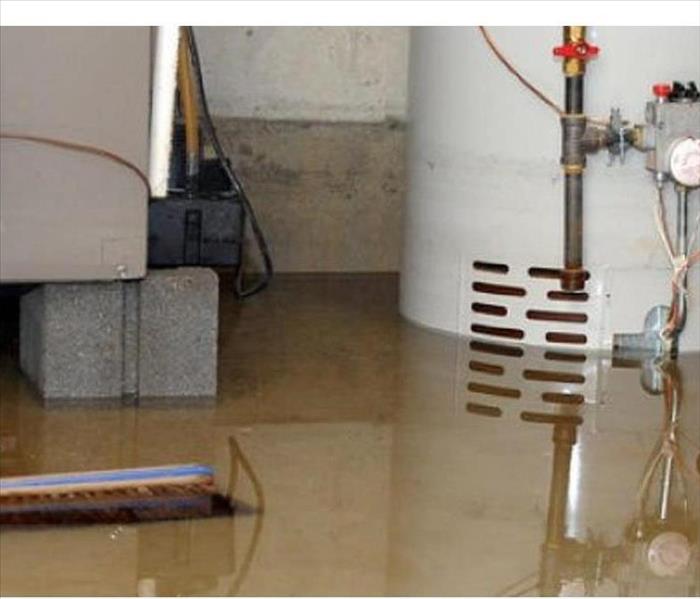 Water Damaged Furnace
Water Damaged Furnace
Every winter, especially if you live in a cold climate, your home is under assault from the elements. Eventually, that constant assault can cause your home’s systems to fail. One common result of these failures is water damage. And while any type of water damage is bad, there are certain types of damage that can be worse than others. That’s especially true in the winter.
Perhaps no system in your home is more important in the winter than your furnace. Without it, you’d be in big trouble. So while the impact of home water damage is bad no matter how you look at it, having your furnace damaged when the temps are freezing outside can be catastrophic. So let’s talk about things you can do to protect your furnace from water damage should the worst case scenario happen to you this winter.
Furnaces are hidden from view for a reason. They’re not exactly focal points of a home you want people’s eyes drawn towards. Whether it’s in a crawl space, basement or mechanical closet, it’s typically in a place you naturally don’t find yourself visiting very often. One way to help protect your furnace from water damage is to create an elevated platform upon which the furnace can sit. If it’s the case your furnace is found in an unfinished basement, you can simply pour a concrete block and install the furnace there. If it’s in a closet, it may make more sense to create a wooden box to hold the furnace. In either case, having the additional 18-24″ of height can typically protect against most types of home water damage. Granted, in massive flood events this isn’t going to have much effect, but then again there isn’t much you can do from a preventative stand point when mother nature decides to take charge.
Please call SERVPRO for any restoration needs that you may have. 757-431-1400
5 Things You Need To Know About Water Damage Statistics
12/4/2017 (Permalink)
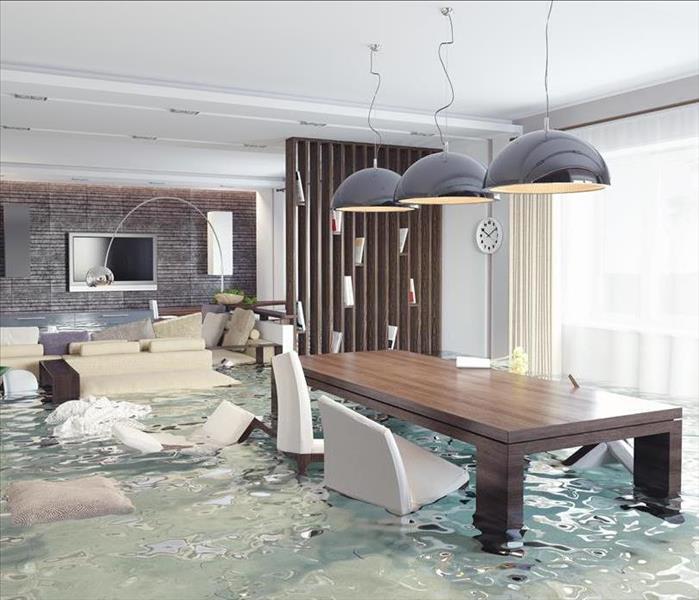 Water damage
Water damage
When a pipe bursts, a drain backs up, or a flood occurs in your home, it can be hard to see past the mess. A million questions will run through your mind.
What do I do now?
What’s going to happen?
Is my stuff ruined?
And the most important question of all: Will my homeowner’s insurance cover the damage?
There’s no doubt about it. Water damage is extremely stressful, and the more you know about it, the better you’ll be able to decide how to address it. Here are five things that every homeowner needs to know about water damage.
1. There are different insurance policies for flood damage and water damage.
You might think that water is water, whether it’s from flooding or a burst pipe, but flood damage is not covered under homeowner’s insurance. If you live in an area likely to experience flooding, you will probably already have a separate policy through the National Flood Insurance Policy (NFIP). When you report the claim to the insurance company, make sure to specify whether the claim is for water damage or for flood damage, so they can begin adjusting your claim correctly.
2. Not all water damage is covered by your insurance.
It is a good idea to look over your insurance policy and familiarize yourself with any exclusion to your water damage coverage. For instance, most policies cover sudden damage, like water damage from a really bad storm or from an overflowing washing machine. On the other hand, any water damage that happens because you didn’t maintain the property may be excluded, as well as gradual leaks that caused water damage over time.
3. Once water damage has happened, the clock is ticking before it gets worse.
When your property has been water damaged, you don’t have the luxury of waiting around for a convenient time to start the cleanup. Secondary damage from mold growth can present serious health risks associated with mold in the living environment.
Mold spores are everywhere, but they need moisture and a nutrient source to grow. And that is exactly what your wet carpet or drywall offers.
There is a 24 to 48 hour window from the time something gets wet until mold CAN begin to grow. After that time, mold will multiply rapidly. When mold growth is widespread, you may need the services of SERVPRO mold remediation service to safely treat and remove the mold.
To prevent mold growth, you will need to get your property completely dry again within that 48-hour window. To do this, you’ll need to contact a company that specializes in water damage restoration and emergency water extraction. They will have the professional water removal equipment and drying equipment to get the job done as quickly as possible. Many have 24-hour a day emergency hotlines, so you can start recovering your property almost immediately.
4. Your insurance company needs to know right away.
It’s a good idea to call your insurance company right away when you discover water damage. Your insurance agent can start the claims process immediately, as well as guide you through the first steps you will need to take to protect your property from more damage, like stopping the source of the water at the main water turnoff.
5. The pollution level of the water is important.
Water damage is categorized as one of three levels by how polluted the water source was that caused the damage.
Category 1: Water from a clean water source, like a fresh water line for a dishwasher. This water will not cause illness or any ill effects.
Category 2: Water that may cause illness through contact. It may have bacteria in it,
Even though water may start out as Category 1, that doesn’t mean it will stay that way. Any contamination that the water touches, such as dirty carpeting or soil from the ground, can change water damage Category to 2 or even Category 3. And since standing breeds bacteria, the longer the water is around, the worse the contamination of your property.
More contamination can mean that the restoration team will have to use more aggressive measures to clean your structure and property, and it might mean that soft furnishings, like your carpet and the carpet pad, may have to be discarded for your safety.
Water damage can be dangerous and expensive, so preventing water damage is an important part of home maintenance. But if you know the basics of what to do once it happens, you can prevent it from doing its worst.
Call SERVPRO for any water damage restoration you may have. 757-431-1400
Water Damage Statistics
12/4/2017 (Permalink)
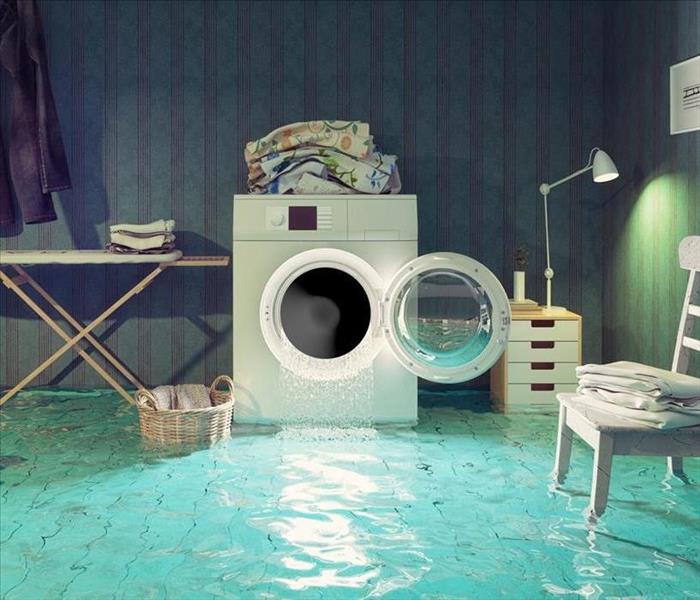 Water Damage
Water Damage
Water Damage Statistics
Water damage covers a broad range of potential loss. Homeowners understand that wear and tear will occur in any circumstance; however, there are a variety of unforeseen events that may trigger water damage. Natural disasters are often given the most blame for water damage, and they should, considering that the majority of damages due to water stem from some sort of outside environmental factor.
Nevertheless, water damage may come in a variety of forms. Understanding the sources of this type of damage is important to not only potentially preventing an incident, but more importantly, to understand where you stand in the eyes of your insurance provider. Water damage in homes most typically comes from the following causes:
- Frozen pipes
- Leaking pipes
- Leaky roof
- Broken washing machine hose
- Plumbing problems
- Insulations issues
The water damage statistics below will highlight the widespread nature of this issue. While many people do not view this as a common occurrence, water damage accounts for a significant number of homeowners insurance claims. The following are some of the most interesting water damage statistics:
- Almost 40 percent of all homeowners have said that they have experienced loss from water damage
- About 93 percent of all water damage can be prevented
- Water damage is the second most frequently filed insurance claim in the United States
- 250 gallons of water is released a day due to a 1/8-inch crack in a pipe
- About 20 percent of all insurance claims related to water damage of some kind
- Billions of dollars in property losses are spent each year as a direct result of water damages
Those homeowners with an understanding of the prospective damages associated with water are much more likely to stop problems before they become major issues. Hopefully these water damage statistics were able to shed some light on the vast complications that may arise from water in the home. If you or your family has experienced water damage and are looking to file a claim, contact Arguello, Hope & Associates for more information.
To get started today, simply fill out a Free Case Review form on this page.
Water Damage Insurance Coverage
First and foremost, homeowners must maintain an understanding of exactly what is and is not covered under their current insurance policy. Without this knowledge, homeowners will be left in shock when disaster strikes and they must pay for these damages out of pocket. Besides purchasing a flood policy for protection, you may be able to add coverage to your existing policy. These additions may cover things such as the following:
- Mold remediation (varies on state)
- Backup of drains or sewers
- Plumbing water damage
- Air conditioning damages
- Water heater damage
Homeowners must be astute in recognizing water damage as early as possible. When a sudden storm, plumbing issue, or sewer backup occurs, knowing what will be covered will ease stress and make the entire repair process much more fluid. To find out more, contact our SERVPRO franchise at 757-431-1400.
Ways to Spot Frozen Pipes
10/25/2017 (Permalink)
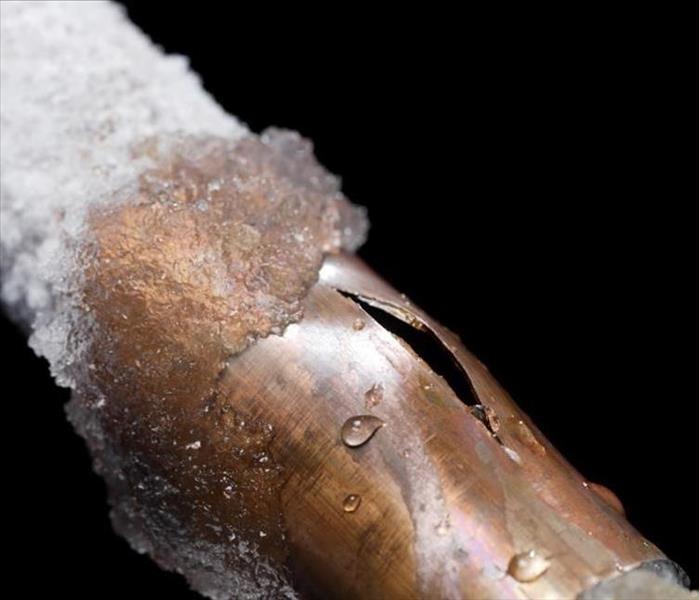 Frozen Pipe
Frozen Pipe
As the weather begins to transition into the colder months there are certain precautions homeowners should begin to take to keep their home safe under freezing conditions.
One of the most common headaches homeowners face during the colder months are frozen pipes.
Have you ever placed a can of soda in the freezer and simply just forgot about it and by the time you realized you forgot the can has already exploded making a mess of your freezer? Well, when water freezes in a pipe, it expands in the same way. If it expands enough, the pipe bursts and water escapes leaving serious damage as a result.
Pipes in attics, crawlspaces, and outside walls are all vulnerable to freezing, especially if there are cracks or openings that allow cold, outside air to flow across the pipes. Holes in an outside wall where television, cable or telephone lines enter can provide access for cold air to reach pipes.
Pipes tend to freeze after consecutive days and nights of freezing (32degrees Fahrenheit) and below freezing temperatures.
Frozen pipes should cause many homeowners concern, for bigger issues may and will arise. If you are unaware of the status of your pipes or what are some clues of a frozen pipe here’s a few signs that may help you.
- A slow stream of water, or no water at all coming through.
- Visible frost on your pipes
- Unusual loud sounds coming from your faucets
- Strange odors coming from your faucets
If any of these signs appear then it likely means your pipes have burst. If this is true, you must act fast, a few things you can do to prevent any further damage.
- This first step is to always shut down your property’s main water supply. (Depending on the amount of water and location, you may want to first turn off electricity.)
- If it’s heated water that’s coming from the broken pipe, you should also close the valve attached to your hot water heater.
- After you’ve shut down the water, call a plumber for help with repairing or replacing the burst pipe.
During this time of need, make SERVPRO of Virginia Beach your first call to help you and your local insurance agent assess the damage. We will work for you to restore your property and your life to make it "Like it never even happened."
Water Damage Facts vs. Fiction
10/25/2017 (Permalink)
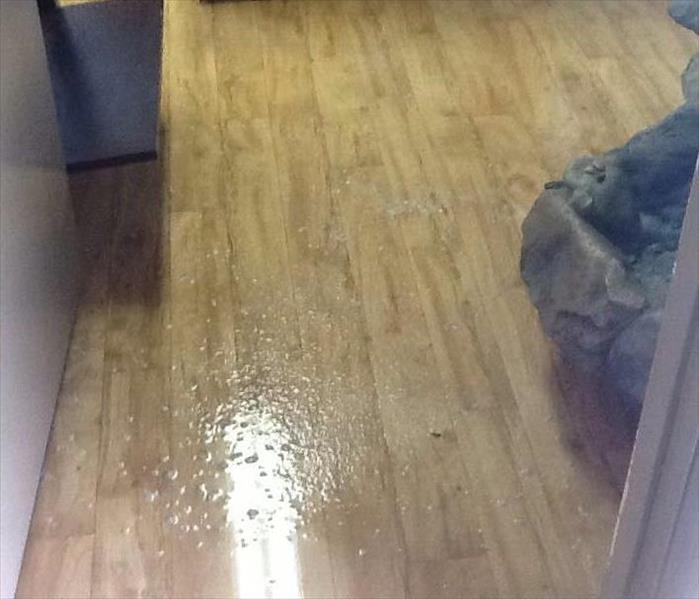 Water Damage
Water Damage
Water damage is a common problem. Most homes will have water damage at some point. There are a lot of myths about water damage.
Myth: Insurance Will not pay for Water Damage
Fact: In most cases, home insurance and renters insurance will pay for water damage. However, every company is different. Make sure that you ask your insurance provider if they will pay for water damage.
Myth: You can Take Care of Water Damage Yourself
Fact: You should always call a professional if your home has water damage. If water damage is not handled properly, then mold can develop. You may also end up spending more money in the long run if you do not get water damage repaired by a professional.
Myth: Water Removal can Wait
Fact: You do not want to wait. The longer you wait, the more likely your home is to develop mold. The water may also damage your floor and possessions.
Myth: Water Damage is not There if you Cannot see It
Fact: You may not be able to see the water damage. The water may in the ceiling or walls. A professional will be able to find the hidden water.
Myth: Water Removal is the Only Thing That is Necessary
Fact: Water removal is the first step. However, there are several other things that need to be done after all of the water is removed. The professional will have to sanitize and disinfect the area. They will also have to apply an anti-fungicide to the area in order to prevent microbial growth.
Myth: Water Damage Does not Smell
Fact: Mildew has a musky smell.
If you need a water damage specialist please call our water damage restoration experts at SERVPRO of Virginia Beach at 757-431-1400
It's The Water You Don't See...
10/25/2017 (Permalink)
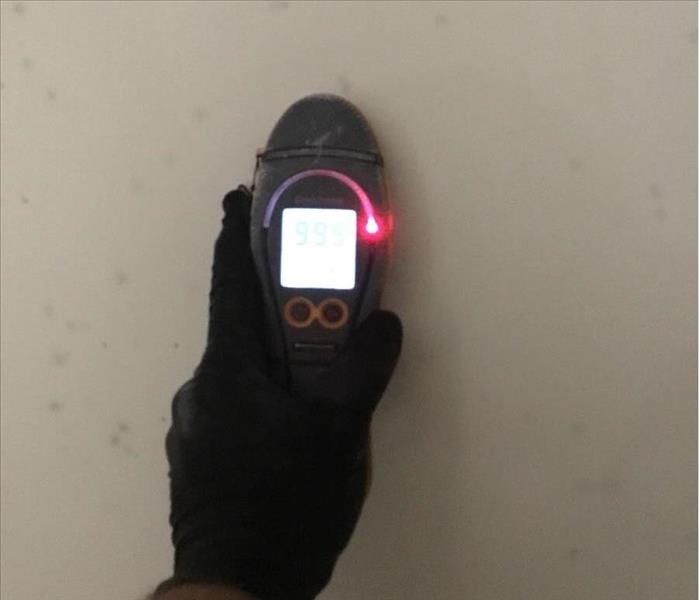 Moisture Readings
Moisture Readings
It's The Water You Don't See...
Even small water damages have the potential to cause serious structural and indoor air quality issues over time.
The key to avoiding costly future restoration is to handle every water problem as a real threat to your property. The proper equipment makes a measurable difference in reducing the damage expense during a water loss. When time matters most, technology and equipment must be counted on to perform.
Here are a few tools used by Professional Restoration Contractors to properly mitigate a loss;
Moisture Sensors- used to detect moisture in carpets, baseboards and walls.
Moisture Meters- used to determine the actual moisture content of various materials. The meter provides accurate readings to monitor the drying process.
Thermohygrometers- measures temperature and relative humidity to calculate and create an environment most conducive to drying. When handling a contaminated loss (CAT 2 or 3), it is not only important to dry the structure, but disinfect and often deodorize.
Ultra Low-Volume (ULV) Foggers- used to atomize liquid deodorizing agents, producing a fine mist that can easily penetrate the site where odor-causing residues may accumulate. It can also be use to inject fungicides and disinfectants into wall cavities and other hard-to-reach areas.
Thermal Foggers- dispenses solvent-based products by creating a dense fog that consists of tiny particles of deodorant solution that attach to and neutralize odor causing particles.
The bottom line... ALWAYS treat a water damage seriously. Call a professional contractor that is trained and experienced in property damage restoration.
Call SERVPRO of Virginia Beach for any restoration needs you may have at 757-431-1400.
Always Be Prepared! -- How to Prepare for Winter Weather and Avoid Water Damage
1/5/2017 (Permalink)
As seasons change, so do property owners preparation checklists. With winter weather upon us, it is important for homeowners and property managers to do everything they can do to reduce risks of costly water damage caused by frozen pipes.
When water freezes, it expands. That’s why a can of soda explodes if it’s put into a freezer to chill quickly and then forgotten. When water freezes in a pipe, it expands the same way. If it expands enough, the pipe bursts and water escapes leaving serious damage as a result.
Pipes in attics, crawlspaces, and outside walls are all vulnerable to freezing, especially if there are cracks or openings that allow the cold, outside air to flow across the pipes. Holes in an outside wall where television, cable or telephone lines enter can provide access for cold air to reach pipes.
The Red Cross warns that pipe freezing is likely to occur after consecutive days and nights of freezing (32 degrees) or below conditions. Taking the following precautions ahead of time can help you prevent potential pipe catastrophes:
- Keep a slow trickle of water flowing through faucets, especially if the pipes for faucets run through unheated or uninsulated areas of your home. Allowing cold water to trickle from a faucet can alleviate pressure and prevent a rupture even if freezing occurs.
- If a vacant home, keep the temperature above 65 degrees.
- Cap outdoor water fixtures. By placing a cover on outdoor spigots and faucets, it reduces the possibility these fixtures build up with ice.
- Keep cabinet doors open during cold spells. This allows warm air to circulate around pipes.
If you have done nothing to prevent frozen pipes and you have water leaking or you have no water pressure, it likely means your pipes have burst. According to State Farm Insurance, this happens to more than 50 million families each year in the United States. If a pipe has even 1/8” crack, it can release 250 gallons of water a day.
You must act fast to prevent further, and more costly damage.
- This first step is to always shut down your property’s main water supply. (Depending on the amount of water and location, you may want to first turn off electricity.)
- If it’s heated water that’s coming from the broken pipe, you should also close the valve attached to your hot water heater.
- After you’ve shut down the water, call a plumber for help with repairing or replacing the burst pipe.
Make SERVPRO of Virginia Beach your first call to help you and your local insurance agent assess the damage. We will work for you to restore your property and your life to make it Like It Never Happened®.





 24/7 Emergency Service
24/7 Emergency Service

